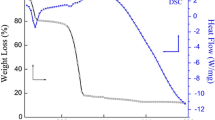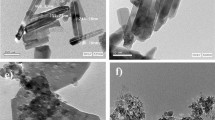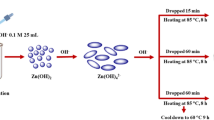Abstract
Zinc oxide (ZnO) nanostructures have been successfully synthesized via template-assisted and template-free route using three different synthetic methods, i.e., sonochemical, mechanochemical, and hydrothermal. Biopolymer xanthan gum (XG) served as sacrificial template for ZnO synthesis as provided the surface for the growth of nanostructures in a controlled manner. The employment of multifarious synthetic techniques resulted in fabrication of ZnO nanoparticles with diverse morphologies such as needle shaped, hexagonal, and spherical particles. Further, the template-assisted protocols generated thermally stable highly crystalline nanostructures along with high surface area, larger pore size, and low band gap energies in contrast to template-free protocol. The structural and other physicochemical studies were manifested by XRD, N2 adsorption desorption, FESEM, TGA, and UV–Vis spectral analysis. The template-assisted ZnO nanostructures were explored as a potential photocatalyst for the catalytic degradation of emerging pollutants, i.e., triclosan (TCS) and imidacloprid (IMD) under the exposure of UV light. The products formed during the photocatalytic reaction were monitored by UV–Vis spectroscopy and HPLC. The results obtained revealed the high catalytic efficiency of ZnO synthesized via template-assisted sonochemical method for TCS (99.60%) and IMD (96.09%) which is attributed to the high surface area and lower band gap energy of the catalyst. The high catalytic potential of the sonochemically synthesized ZnO also substantiated from the kinetic data as high-rate constant was obtained. Thus, the template-assisted protocols developed led to preparation of nanostructures having tailored properties for efficient photocatalysis and can rapidly degrade selected emerging contaminants such as personal care products and organophosphate pesticides. Hence, environment-friendly synthesized photocatalyst can be appropriately employed to wastewater treatment contaminated with emerging pollutants.

















Similar content being viewed by others
Data availability
All data generated or analysed during this study are included in this article.
References
Alomair NA, Mohamed HH (2018) Green synthesis of ZnO hollow microspheres and ZnO/rGO nanocomposite using red rice husk extract and their photocatalytic performance. Mater Res Express 5:095012. https://doi.org/10.1088/2053-1591/aaa469
Amulya MAS, Nagaswarupa HP, Kumar MRA, Ravikumar CR, Prashantha SC, Kusuma KB (2020) Sonochemical synthesis of NiFe2O4 nanoparticles: characterization and their photocatalytic and electrochemical applications. Appl Surf Sci 1:100023. https://doi.org/10.1016/j.apsadv.2020.100023
Bano K, Kaushal S, Singh PP (2021) A review on photocatalytic degradation of hazardous pesticides using heterojunctions. Polyhedron 209:115465. https://doi.org/10.1016/j.poly.2021.115465
Braun PV, Osenar P, Twardowski M, Tew GN, Stupp SI (2005) Macroscopic nanotemplating of semiconductor films with hydrogen-bonded lyotropic liquid crystals. ADV Funct Mater 15:1745–1750. https://doi.org/10.1002/adfm.200500083
Chandra Pragada S, Thalla AK (2021) Polymer-based immobilized Fe2O3–TiO2/PVP catalyst preparation method and the degradation of triclosan in treated greywater effluent by solar photocatalysis. J Environ Manage 29:113305. https://doi.org/10.1016/j.jenvman.2021.113305
Gusain R, Gupta K, Joshi P, Khatri OP (2019) Adsorptive removal and photocatalytic degradation of organic pollutants using metal oxides and their composites: a comprehensive review. Adv Colloid Interface Sci. 102009. https://doi.org/10.1016/j.cis.2019.102009
Hayati P, Mehrabadi Z, Karimi M, Janczak J, Mohammadi K, Mahmoudi G, Rostamnia S (2021) Photocatalytic activity of new nanostructures of an Ag(i) metal–organic framework (Ag-MOF) for the efficient degradation of MCPA and 2,4-D herbicides under sunlight irradiation. New J Chem 45:3408–3417. https://doi.org/10.1039/d0nj02460k
Himanshi T, Harshita C, Hema B, Seema G (2022) Recent-enhancements in visible-light photocatalytic degradation of organochlorines pesticides: review. Mater Today: Proc 49:3289–3305. https://doi.org/10.1016/j.matpr.2020.12.1036
Kaur A, Singh D, Sud D (2020) A review on grafted, crosslinked and composites of biopolymer Xanthan gum for phasing out synthetic dyes and toxic metal ions from aqueous solutions. J Polym Res 27. https://doi.org/10.1007/s10965-020-02271-6
Kaur A, Bajaj B, Kaushik A, Saini A, Sud D (2022a) A review on template assisted synthesis of multi-functional metal oxide nanostructures: status and prospects. Mater Sci Eng B 286:116005. https://doi.org/10.1016/j.mseb.2022.116005
Kaur A, Bajaj B, Sud D (2022b) Biopolymer xanthan gum templated facile synthesis of reusable cerium oxide nanoparticles as catalyst for reduction of nitroaromatic compounds. J Iran Chem Soc 19:4473–4489. https://doi.org/10.1007/s13738-022-02616-6
Kaur A, Sud D (2022) Thionyl chloride facilitated polymerization of xanthan gum grafted copolymers for wastewater remediation by exclusion of synthetic dyes. Polym Environ. https://doi.org/10.1007/s10924-022-02572-5
Khan N, Khan SU, Ahmed S, Farooqi, IH, Yousefi, M, Mohammadi (2019) Recent trends in disposal and treatment technologies of emerging-pollutants- a critical review. Trends Anal Chem 115744. https://doi.org/10.1016/j.trac.2019.115744
Khatoon UT, Rao GN, Mohan MK, Ramanaviciene A (2018) Comparative study of antifungal activity of silver and gold nanoparticles synthesized by facile chemical approach. J Environ Chem Eng 6:5837–5844
Kimling MC, Caruso RA (2012) Sol–gel synthesis of hierarchically porous TiO2 beads using calcium alginate beads as sacrificial templates. J Mater Chem 22:4073–4082. https://doi.org/10.1039/c2jm15720a
Son LL, Cuong ND, Van Thi TT, Hieu LT, Trung DD, Van HieuKonjac N (2019) glucomannan-templated synthesis of three-dimensional NiO nanostructures assembled from porous NiO nanoplates for gas sensors. RSC Adv 9:9584–9593. https://doi.org/10.1039/c9ra00285e
Li JPH, Kennedy EM, Adesina AA, Stockenhuber M (2019a) Mechanistic insights into the Knoevenagel condensation reaction over ZnO catalysts: direct observation of surface intermediates using in situ FTIR. J Catal 369:157–167. https://doi.org/10.1016/j.jcat.2018.10.039
Li Y, Zhang D, Ash J, Jia X, Leone A, Templeton A (2019b) Mechanism and impact of excipient incompatibility: crosslinking of Xanthan gum in pediatric powder-for-suspension formulations. J Pharm Sci 108:3609–3615. https://doi.org/10.1016/j.xphs.2019.07.005
Lin J, Luo Z, Liu J, Li P (2018) Photocatalytic degradation of methylene blue in aqueous solution by using ZnO-SnO 2 nanocomposites. Mater Sci Semicond Process 87:24–31. https://doi.org/10.1016/j.mssp.2018.07.003
Luo M, Huang Y, Zhu M, Tang Y, Ren T, Ren J, Li F (2018) Properties of different natural organic matter influence the adsorption and aggregation behavior of TiO2 nanoparticlesJ. Saudi Chem Soc 22:146–154. https://doi.org/10.1016/j.jscs.2016.01.007
Maciak E, Opilski Z (2007) Transition metal oxides covered Pd film for optical H2 gas detection. Thin Solid Films 515:8351–8355. https://doi.org/10.1016/j.tsf.2007.03.022
Mansor ES, El Shall FN, Radwan EK (2022) Simultaneous decolorization of anionic and cationic dyes by 3D metal-free easily separable visible light active photocatalyst. Environ Sci Pollut Res. https://doi.org/10.1007/s11356-022-22838-8
Masood MT, Qudsia S, Hadadian M, Weinberger C, Nyman M, Ahläng C, Smått JH (2020) Investigation of well-defined pinholes in TiO2 electron selective layers used in planar heterojunction perovskite solar cells. Nanomaterials 10:181. https://doi.org/10.3390/nano10010181
Mostafa H, Alireza M, Ramin N, Amir H, Shahram R, Kazem N (2021) A comprehensive systematic review of photocatalytic degradation of pesticides using nano TiO2. Environ Sci Pollut Res 28:13055–13071. https://doi.org/10.1007/s11356-021-12576-8
Natsathaporn P, Jenjob R, Pattanasattayavong P, Yamsawas D, Crespy D (2020) Photocatalytic degradation of pesticides by nanofibrous membranes fabricated by colloid-electrospinning. Nanotechnology 31:215603. https://doi.org/10.1088/1361-6528/ab713d
Nidhin M, Indumathy R, Sreeram KJ, Nair BU (2008) Synthesis of iron oxide nanoparticles of narrow size distribution on polysaccharide templates. Bull Mater Sci 31:93–96. https://doi.org/10.1007/s12034-008-0016-2
Otis G, Ejgenberg M, Mastai Y (2021a) Solvent-free mechanochemical synthesis of ZnO nanoparticles by high-energy ball milling of ε-Zn(OH)2 crystals. Nanomaterials 11:238. https://doi.org/10.3390/nano11010238
Otis G, Ejgenberg M, Mastai Y (2021b) Solvent-free mechanochemical synthesis of ZnO nanoparticles by high-energy ball milling of ε-Zn(OH)2 crystals. Nanomaterials 11(1):238. https://doi.org/10.3390/nano11010238
Pachiyappan J, Gnanasundaram N, Rao GL (2020) Preparation and characterization of ZnO, MgO and ZnO–MgO hybrid nanomaterials using green chemistry approach. Results Mater 7:100104. https://doi.org/10.1016/j.rinma.2020.100104
Pineda A, Ojeda M, Romero AA, Balu AM, Luque R (2018) Mechanochemical synthesis of supported cobalt oxide nanoparticles on mesoporous materials as versatile bifunctional catalysts. Microporous Mesoporous Mater 272:129–136. https://doi.org/10.1016/j.micromeso.2018.06.029
Radwan EK, Ibrahim MB, Adel A, Farouk M (2020) The occurrence and risk assessment of phenolic endocrine-disrupting chemicals in Egypt’s drinking and source water. Environ Sci Pollut Res 27:1776–1788. https://doi.org/10.1007/s11356-019-06887-0
Radwan EK, Ghafar HHA, Ibrahim MBM, Moursy AS (2022) Recent trends in treatment technologies of emerging contaminants. Environ Qual Manag. https://doi.org/10.1002/tqem.21877
Rafi MM, Ahmed KSZ, Nazeer KP, Siva Kumar D, Thamilselvan M (2014) Synthesis, characterization and magnetic properties of hematite (α-Fe2O3) nanoparticles on polysaccharide templates and their antibacterial activity. Appl Nanosci 5:515–520. https://doi.org/10.1007/s13204-014-0344-z
Rodrigues J, Hatami T, Rosa Jorge M, Basile TE (2019) Photocatalytic degradation using ZnO for the treatment of RB 19 and RB 21 dyes in industrial effluents and mathematical modeling of the process. Chem Eng Res Des 153:294–305. https://doi.org/10.1016/j.cherd.2019.10.021
Rupa EJ, Anandapadmanaban G, Mathiyalagan R, Yang D-C (2018) Synthesis of zinc oxide nanoparticles from immature fruits of Rubus coreanus and its catalytic activity for degradation of industrial dye. Optik 172:1179–1181
Sabaghnia N, Janmohammadi M, Dalili M, Karimi Z, Rostamnia S (2019) Euphorbia leaf extract-assisted sustainable synthesis of Au NPs supported on exfoliated GO for superior activity on water purification: reduction of 4-NP and MB. Environ Sci Pollut Res 26:11719–11729. https://doi.org/10.1007/s11356-019-04437-2
Samadi M, Zirak M, Naseri A, Kheirabadi M, Ebrahimi M, Moshfegh AZ (2019) Design and tailoring of one-dimensional ZnO nanomaterials for photocatalytic degradation of organic dyes: a review. Res Chem Intermed 45:2197–2254. https://doi.org/10.1007/s11164-018-03729-5
Satdeve NS, Ugwekar RP, Bhanvase BA (2019) Ultrasound assisted preparation and characterization of Ag supported on ZnO nanoparticles for visible light degradation of methylene blue dye. J Mol Liq 291:111313. https://doi.org/10.1016/j.molliq.2019.111313
Schmidt W, Eckhardt M, Wisser K, Lenk F, Grothe S, Kaskel J, Reineke S (2019) Efficiency of light outcoupling structures in organic light-emitting diodes: 2D TiO2 array as a model system. Adv Funct Mater 29:1901748. https://doi.org/10.1002/adfm.201901748
Schröder S, San-Román M-F, Ortiz I (2020) Photocatalytic transformation of triclosan. reaction products and kinetics. Catalysts 10:1468. https://doi.org/10.3390/catal10121468
Singh YR, Kuřitka I, Vilcakova J, Jamatia T, Machovsky M, Skoda D, Havlica J (2019a) Impact of sonochemical synthesis condition on the structural and physical properties of MnFe2O4 spinel ferrite nanoparticles. Ultrason Sonochem 61:104839. https://doi.org/10.1016/j.ultsonch.2019.104839
Singh, BK, Lee S, Na K (2019b) An overview on metal-related catalysts: metal oxides, nanoporous metals and supported metal nanoparticles on metal organic frameworks and zeolites. Rare Metals 1–16. https://doi.org/10.1007/s12598-019-01205
Singha MK, Patra A (2020) Highly efficientand reusableZnO microflower photocatalyst on stainless steel mesh under UV–Vis and natural sunlight. Opt Mater. 110000. https://doi.org/10.1016/j.optmat.2020.110000
Solá-Gutiérrez C, Schröder S, San-Román MF, Ortiz I (2020) Critical review on the mechanistic photolytic and photocatalytic degradation of triclosan. J Environ Manage 260:110101. https://doi.org/10.1016/j.jenvman.2020.110101
Suthakaran S, Dhanapandian, S, Krishnakumar, N, Ponpandian N (2020) Hydrothermal synthesis of surfactant assisted Zn doped SnO2 nanoparticles with enhanced photocatalytic performance and energy storage performance. J Phys Chem Solids 109407. https://doi.org/10.1016/j.jpcs.2020.109407
Taghavi R, Rostamnia S, Farajzadeh M, Karimi-Maleh H, Wang J, Kim D, Jang HW, Luque R, Varma RS, Shokouhimehr M (2022) Magnetite metal-organic frameworks: applications in environmental remediation of heavy metals, organic contaminants, and other pollutants. Inorg Chem 61:15747–15783. https://doi.org/10.1021/acs.inorgchem.2c01939
Takahashi K, Limmer SJ, Wang Y, Cao G (2004) Synthesis and electrochemical properties of single-crystal V2O5nanorod arrays by template-based electrodeposition. J Phys Chem B 108:9795–9800. https://doi.org/10.1021/jp0491820
Vaiano V, Iervolino G, Rizzo L (2018) Cu-doped ZnO as efficient photocatalyst for the oxidation of arsenite to arsenate under visible light. Appl Catal B 238:471–479. https://doi.org/10.1016/j.apcatb.2018.07.026
Velempini T, Prabakaran E, Pillay K (2021) Recent developments in the use of metal oxides for photocatalytic degradation of pharmaceutical pollutants in water—a review. Mater Today Chem 19:100380. https://doi.org/10.1016/j.mtchem.2020.100380
Wang N, Chen J, Wang J, Feng J, Yan W (2019) Removal of methylene blue by polyaniline/TiO2 hydrate: adsorption kinetic, isotherm and mechanism studies. Powder Tech 347:93–102. https://doi.org/10.1016/j.powtec.2019.02.049
Wang Y, Ma C, Sun X, Li H (2002) Preparation and characterization of SnO2nanoparticles with a surfactant-mediated method. Nanotechnology 13:565–569. https://doi.org/10.1088/0957-4484/13/5/304
Wu G, Zhang L, Cheng B, Xie T, Yuan X (2004) Synthesis of Eu2O3nanotube arrays through a facile sol−gel template approach. J Am Chem Soc 126:5976–5977. https://doi.org/10.1021/ja039012l
Yang B, Zheng J, Li W, Wang R, Li D, Guo X, … Jia X, (2020) Engineering Z-scheme TiO2 -OV-BiOCl via oxygen vacancy for photocatalytic degradation of imidacloprid. Dalton Trans. https://doi.org/10.1039/d0dt02128h
Zhang X, Sun H, Tan S, Gao J, Fu Y, Liu Z (2019) Hydrothermal synthesis of Ag nanoparticles on the nanocellulose and their antibacterial study. Inorg Chem Commun 100:44–50. https://doi.org/10.1016/j.inoche.2018.12.012
Zhou Y, Schattka JH, Antonietti M (2004) Room-temperature ionic liquids as template to monolithic mesoporous silica with wormlike pores via a sol−gel nanocasting technique. Nano Lett 4:477–481. https://doi.org/10.1021/nl025861f
Author information
Authors and Affiliations
Contributions
All authors contributed to the study conception and design. Material preparation, data collection, and analysis were performed by Vidhi, Gagandeep Kaur, and Arshpreet Kaur. The first draft of the manuscript was written by Arshpreet Kaur and authors commented on previous versions of the manuscript. Dhiraj Sud read and approved the final manuscript.
Corresponding author
Ethics declarations
Ethical statement
This material is authors’ own original work which has not been published elsewhere.
Consent to participate
All authors declare that they participated in the study and development of the manuscript.
Consent for publication
All authors read the final version of the manuscript and give consent for the article to be published.
Competing interests
The authors declare no competing interests.
Additional information
Responsible Editor: George Z. Kyzas
Publisher's note
Springer Nature remains neutral with regard to jurisdictional claims in published maps and institutional affiliations.
Rights and permissions
Springer Nature or its licensor (e.g. a society or other partner) holds exclusive rights to this article under a publishing agreement with the author(s) or other rightsholder(s); author self-archiving of the accepted manuscript version of this article is solely governed by the terms of such publishing agreement and applicable law.
About this article
Cite this article
Kaur, A., Mehta, V.S., Kaur, G. et al. Biopolymer templated strategized greener protocols for fabrication of ZnO nanostructures and their application in photocatalytic technology for phasing out priority pollutants. Environ Sci Pollut Res 30, 25663–25681 (2023). https://doi.org/10.1007/s11356-023-25234-y
Received:
Accepted:
Published:
Issue Date:
DOI: https://doi.org/10.1007/s11356-023-25234-y




